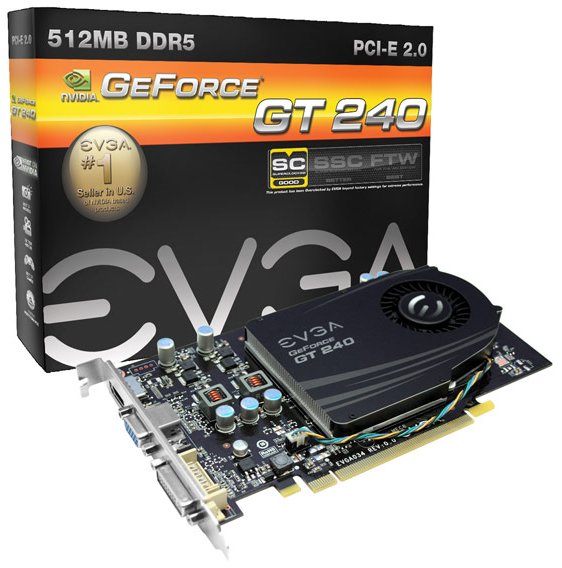GeForce GT 240
The GeForce GT 240 is equipped with four TPC texture processing clusters, each containing 24 stream processors, for a total of 96 compute cores. Similar to the GeForce GTX 280, each TPC cluster contains eight TMUs, for a total of 32 texture units. Two 64-bit ROPs are capable of processing four pixels per clock each, while they are connected to a 128-bit memory bus and can perform eight raster operations per clock. Thus, we can expect the GT 240 to provide less than half the processing power of the GeForce GTX 285.

The new GeForce GT 240 is also being built on TSMC's 40nm process, which has allowed Nvidia to make more profit from its sub-$100 GPUs compared to the 55nm and 65nm versions. Of course, the new processor has common features compared to the G 210 and GT 220 models, namely support for DirectX 10.1 and Shader Model 4.1, output of eight channels of LPCM audio, and improved support for playback of DivX, VC-1 and MPEG-2 video codecs. The GeForce GT 240 is not only certified to support CUDA and PhysX, but also supports GeForce 3D Vision glasses.
But the biggest difference with the Nvidia GeForce GT 240 lies in memory support. While the GeForce GT 220 is limited to DDR2 and GDDR3 support, the new GeForce GT 240 can handle both DDR3 and GDDR5. This is important because GDDR5 memory delivers twice the theoretical bandwidth per clock compared to DDR2 and GDDR3. The beauty of the solution is that it allows the GeForce GT 240 to provide similar bandwidth compared to graphics cards equipped with GDDR3 memory with a 256-bit memory interface (like the 9600 GT), while still keeping the cost low. GDDR5 memory was one of AMD's strengths when it introduced the Radeon HD 4800 line, and now it's Nvidia's turn to embrace the technology. It's also the first time we've seen GDDR5 memory on a sub-$100 graphics card.
Specifications NVIDIA GeForce GT 240
| Name | GeForce GT 240 |
| Core | GT215 |
| Process technology (µm) | 0.04 |
| Transistors (million) | ? |
| Core frequency | 550 |
| Memory frequency (DDR) | GDDR5 850 (3400)/GDDR3 1000 (2000)/GDDR3 900 (1800) |
| Bus and memory type | 128-bit |
| Bandwidth (Gb/s) | 57.6 |
| Unified shader blocks | 96 |
| Frequency of unified shader units | 1340 |
| TMU per conveyor | 32 |
| ROP | 8 |
| Shader Model | 4.1 |
| Fill Rate (Mpix/s) | 4400 |
| Fill Rate (Mtex/s) | 17600 |
| DirectX | 10.1 |
| Memory | 512/1024 |
| Interface | PCI-E 2.0 |
The GeForce GT 240 also stands out because it was the only reference card in this performance segment without a separate auxiliary power connector. As a result, it directly competes with the Radeon HD 4670, the previous "performance king" among reference graphics cards without an additional PCIe power connector.



